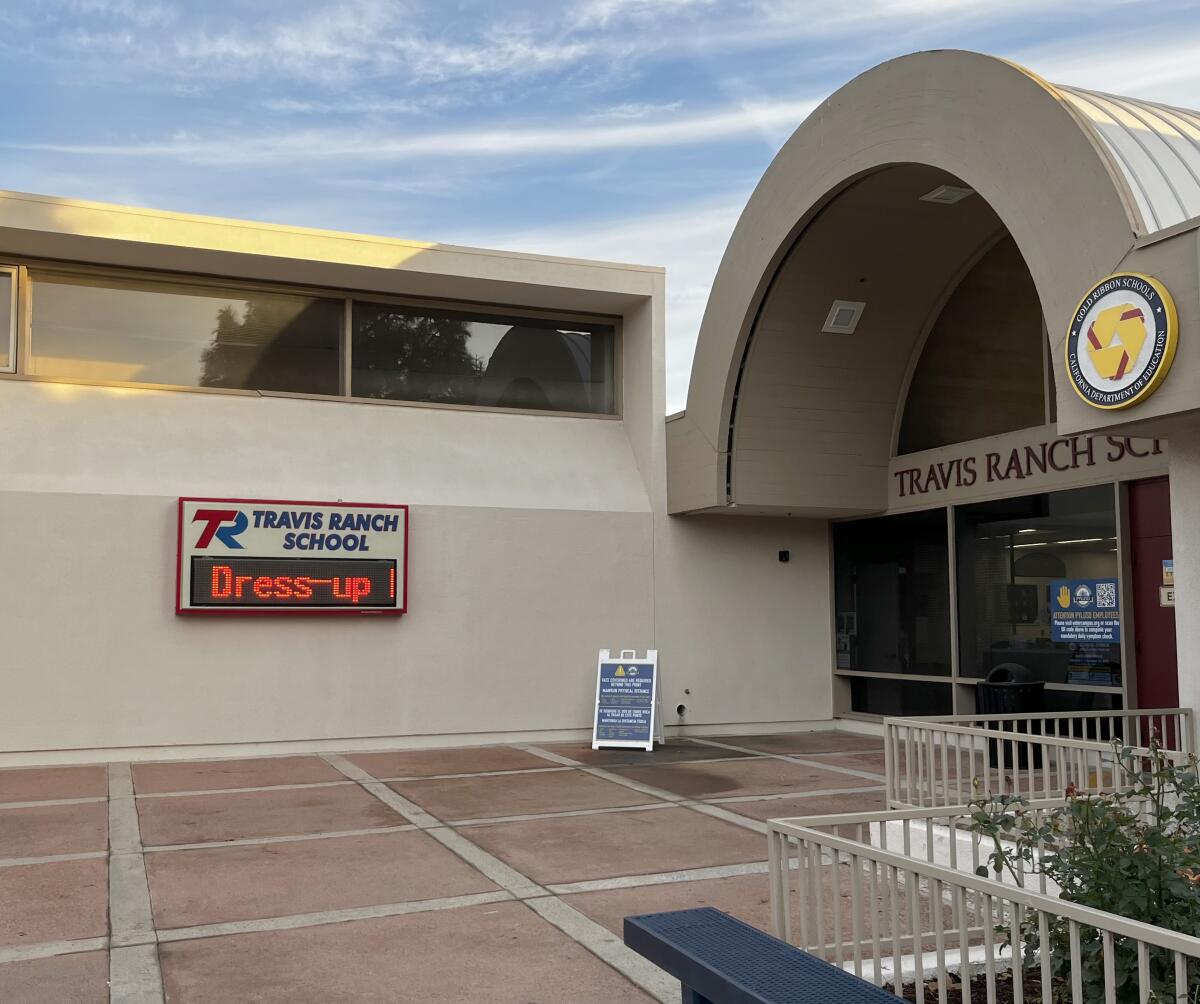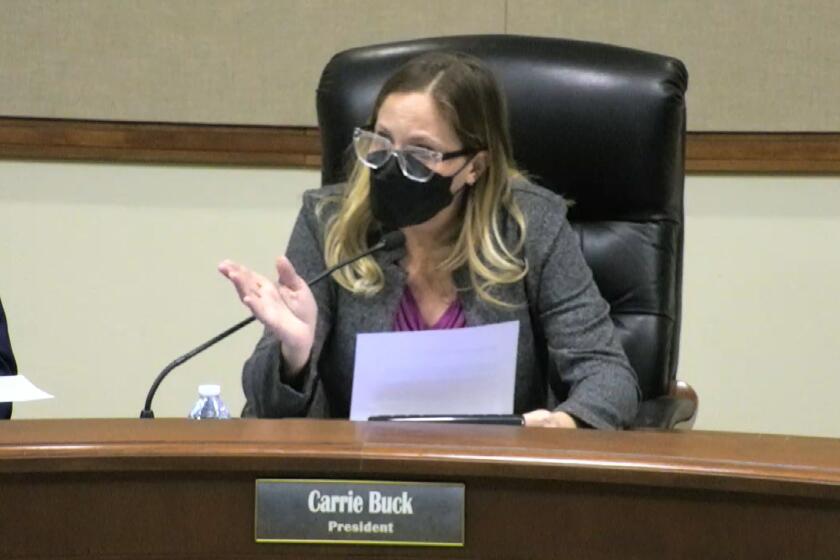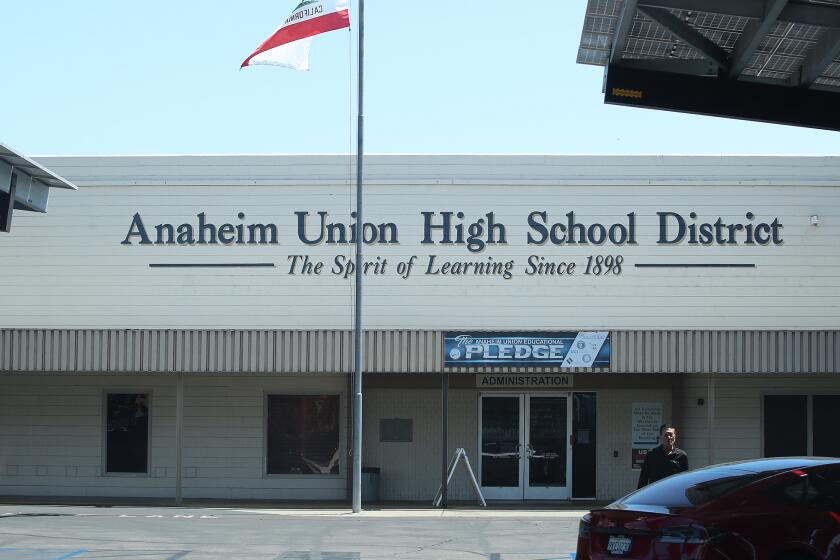Early outbreak overwhelmed Yorba Linda school as Omicron found foothold in O.C.

Before rampant absences and staff shortages characterized a roughshod return to class from winter break in school districts across Orange County, an outbreak in Yorba Linda proved to be an early crucible of coronavirus chaos in the latest surge.
Travis Ranch School, a site that enrolls students in both elementary and middle school, charted a spike in cases severe enough to cause administrators to quarantine the entire sixth-grade class a week before winter break.
When students temporarily returned to remote learning on Dec. 15, the Placentia-Yorba Linda Unified School District reported 54 positive COVID-19 cases at Travis Ranch School, including one staffer, within the previous two weeks on its dashboard.
At the time, the outbreak served as an outlier but also a harbinger of things to come for the rest of the county when classes resumed after winter break amid a tidal wave of coronavirus cases fueled by the highly contagious Omicron variant.
Taking an inside look at the outbreak, TimesOC requested public records from both the district and the Orange County Health Care Agency.
The district provided 83 partially redacted nurse investigation checklist forms and emails from staff to county health officials while OCHCA withheld responsive records, citing confidentiality.
A protest, an alleged assault and a school board meeting’s early adjournment fuel continuing controversy.
“Without getting into the specifics on a particular situation, what we have seen, has been less transmission in schools,” wrote Dr. Christopher Zimmerman, OCHCA’s public health medical director, in an email. “The requirement for consistent mask wearing in schools is likely a major factor in this. But what goes on outside of schools, in the community, still impacts schools.”
Forms obtained by TimesOC show diligent safety protocols undertaken by school officials that involved investigating cases, identifying close contacts, notifying parents and testing students.
Still, the slew of COVID-19 cases overwhelmed those efforts to maintain classes at Travis Ranch School without disruption and correlated with sequenced Omicron cases surfacing and then spiking in the county, as data would later reveal.
An uptick in coronavirus cases spread beyond sixth-grade students, as well.
Despite mask compliance at school and early detection in most lower-grade cases reviewed between Nov. 3 and Dec. 21, students in K-5 classrooms still found themselves exposed to the coronavirus.
According to one nurse investigative checklist form, an unvaccinated individual — it’s unclear whether student or staff — reported showing symptoms of a runny nose and a cough on Dec. 2. That person remained at school for an infectious period of almost two weeks before being sent home. A positive test followed the next day, but by that time an entire classroom had to be considered a “close contact.”
In a previous statement to ABC-7, Dr. Regina Chinsio-Kwong, deputy county health officer, commented on her agency’s probe of the outbreak and noted an instance when an unvaccinated, symptomatic adult had come into close contact with a classroom of mostly unvaccinated children.
“It would have helped if more people at the school were vaccinated,” she said.
Handwritten notes on another form showed that OCHCA helped determine that the reported sneezing of an unvaccinated lower-grade student the day before a positive COVID-19 test indicated the onset of symptoms from the disease.
In that case, an entire class of 25 students was to be tested, in addition to two other close contacts.

By Dec. 10, the rise of cases in students prompted alarm, as well as an email from the lead district nurse to an OCHCA official.
“We have approximately 40 cases (some just came in within the last hour) spanning many grades,” wrote Michelle DeHaven that day. “Next week we have several assemblies scheduled. Some during school hours and some after school. Would it be your recommendation that we refrain from holding any assemblies and/or extracurricular performances at this time with large gatherings of students/staff and parents next week?”
Before the lead district nurse posed the question, private gatherings held off campus contributed to more positive cases identified among middle school students.
A form regarding one unvaccinated student ill with COVID-19 prompted contract tracing efforts to identify a birthday party where 25 students attended and didn’t wear masks outside as they socialized for hours.
The gathering appeared again on the form of another ill upper-grade student who attended the sixth-grade birthday party with other Travis Ranch School classmates.
An off-campus Girl Scouts Christmas gathering was also held the same date as the birthday party. An unvaccinated student attended after already experiencing an onset of coronavirus symptoms, including a cough and sore throat. The same symptoms showed up in another unvaccinated upper-grade student who was a close contact of an infectious Girl Scout friend.
The positive cases started to roll in the week of Dec. 6, which prompted Travis Ranch School Principal Taylor Holloway to notify parents in an email alert sent three days later.
“A large majority of the cases reported to us originated outside of campus,” she wrote.
By Sunday, Dec. 12, DeHaven alerted an OCHCA official of the decision to quarantine the entire sixth-grade class.
“The results are just beginning to come in this morning,” she wrote. “We are getting an accurate count now, but there are at least 24 positive sixth-grade students.”
Holloway followed later that day with the announcement to parents, a move prompted by positive tests returning for students identified as close contacts. Assemblies and other after-school activities for students who remained on campus would be cancelled or postponed.
But was Omicron to blame for upending Travis Ranch School before winter break?
The OCHCA didn’t issue a press release about the first confirmed Omicron case in the county until Dec. 17. It provided scant details about a fully vaccinated man who had traveled domestically, contracted Omicron and experienced mild illness.
Many of the Travis Ranch School nurse investigative checklist forms from December note sore throats among the symptoms of COVID-19 positive students, an early sign of an Omicron infection as it became later known.
But OCHCA didn’t respond to specific questions about whether the agency suspected, confirmed or ruled out Omicron as a driver of the outbreak identified at Travis Ranch School, even when presented with correlating evidence.
According to data posted on OCHCA’s website, the first Omicron case in the county was sequenced as early as the week of Nov. 1. A month later, 11 sequenced Omicron cases were detected during the week of Dec. 6, the same week a number of Travis Ranch School students started falling ill within three days of attending off-campus private gatherings.
By the following week, the number of sequenced Omicron cases in the county exploded twelvefold to 139; the Delta variant accounted for 61% of sequenced cases before being displaced by winter break.
As noted by the data, sequenced cases don’t reflect the total number of infections caused by Omicron.
During winter break, the Yorba Linda ZIP code that encompasses Travis Ranch School posted a test positivity rate of 7.5%, the highest in the county at the time.
Reports of positive cases among students continued to pour in, but as the nurse forms noted, contact tracing efforts ceased during winter break.
All the latest on Orange County from Orange County.
Get our free TimesOC newsletter.
You may occasionally receive promotional content from the Daily Pilot.





